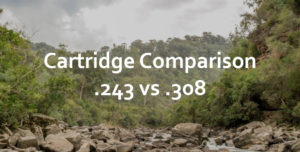Comparing the .270 Winchester vs .308 Winchester
While the .270 Winchester and .308 Winchester are extremely versatile and effective medium game cartridges, they are quite different regarding origins and initial purposes.
Besides that, it’s obvious that the .270 Winchester and .308 Winchester rounds have very different external dimensions.
| .270 Winchester | .308 Winchester | |
| Bullet Diameter | .277” (6.9 mm) | .308” (7.8 mm) |
| Case Length | 2.540 in (64.5 mm) | 2.035” (51.7 mm) |
| Overall Length | 3.25” (82.55 mm) | 2.80” (71.1 mm) |
| Rim Diameter | .473” (12.0 mm) | .473” (12.0 mm) |
| Case Capacity | 67gr H2O (4,3 cm3) | 56 gr H2O (3.6 cm3) |
| Max Pressure (SAAMI) | 65,000 psi (450 MPa) | 62,000 psi (430 MPa) |
| Muzzle Velocity | 3.140 fps (957 m/s) | 2,820 fps (860 m/s) |
| Muzzle Energy | 2,846 ft-lbs (3,859 J) | 2,648 ft-lb (3,590 J) |
| Bullet | 130 gr (7.12 g) | 150 gr (9.72 g) |
| Powder Load | 48.2 gr (3.10 g) | 46.3gr (3.0 g) |
| Rifle Weight | 8,0 lb. (2.95 kg) | 7,5 lb. (3,4 kg) |
| Free Recoil Energy | 17,64 ft-lbs (23,9 J) | 18,27 ft-lbs (27,7 J) |
The .30-06 Springfield – the progenitor of the .270 Winchester and .308 Winchester
While both of these cartridges have different strengths and weaknesses, they draw roots from the same parent – the .30-06 Springfield.
Designed at the start of the 20th century, the .30-06 descended from the .30-03 Springfield, which in turn was developed after the 7x57mm Mauser, a new revolutionary cartridge designed for the German Mauser Model 1893 rifle.
The new cartridge loaded with a 150gr pointed bullet and fired at 2,700fps, was an instant success and a gigantic improvement over other popular American cartridges used during that era. This wildly successful chambering became an immediate commercial powerhouse, accepted by many hunters and civilian shooters.
.270 Winchester
The story of the .270 was somewhat different from than brilliant path of the .30-06.
Soon, after the .30-06 was adopted as a universal calibre suitable for all game animals across North America, the wildcatters started modifying the .30-06. Many of them necked up the .30 calibre cartridge to accept bullets of larger diameter to optimise certain performances such as the power, size, or efficiency. As a result, the .35 Whelen and the .400 Whelen were introduced to the commercial market.
The most repeated cliché claims that the Winchester went the opposite route and decided to neck down the .30-06 to accept a smaller diameter bullet, instead of .308″ bullets. However, the Winchester designers narrowed down the old .30-03 case to accept a 0.277-inch diameter bullet.
Speaking of numbers, the case length of a .30-06 Springfield is 63.3mm (2.494 in), whereas the case length of a .30-03 is 64.5 millimeters (2.540 in), the same as a .270 Winchester. Taking into account that fact, some handloaders point out that a better option for .270 Win handloading is using the brass formed from the .35 Whelen or .280 Remington cases.
While both cartridges have the same .473″ rim diameter, the .270Win is used in standard/long action rifles, while the .308Win has a shorter case length and fits into a short action rifle. Theoretically, it means you would be able to deliver faster follow-up shots from a .308 than a .270. However, the .270 has lower felt recoil than the .308, and that feature will often translate to increase downrange accuracy because most hunters could comfortably handle the .270 recoil level.
Besides that, another peculiarity of .270 Winchester is its caliber, as it uses .277″ bullets instead of the much more popular .284″ bullets. Although it was a somewhat perplexing decision, some gun authors believe Winchester utilised this unique caliber to prevent being similar to anything already existing in old Europe or Britain at the time.
Even today, there are only a few cartridges loaded with the 0.277″ projectiles, such as the 6.8 Remington SPC, the 270 Winchester Short Magnum (270 WSM), and the .270 Weatherby Magnum.
On the other side, there are considerably more hunting cartridges using bullets of 7.2mm or .284″ calibre, to name just a few like the 7mm-08, 7mm Remington Magnum, .280 Remington, and .280 Ackley Improved.
Anyway, the .270 Win, as the necked down version of the .30-03, was released to the commercial market in 1925, chambered in the Winchester Model 54 bolt-action rifle. However, the timing wasn’t right for it, since by the 1920`s a sporterised .30-06 U.S military cartridge had proven itself as a very effective hunting round, affecting the .270 to go largely unnoticed at the time.
Despite the fact the .270 was a relatively obscure calibre in its infancy, the .270 Winchester eventually became one of the two most popular non-military big-game cartridges introduced before World War II.
Designed as a lightweight version of the .30-06, the .270 Winchester utilised lighter bullets than the -06, resulting in a flatter shooting trajectory, somewhat a lower felt recoil and long-range capability.
The initial factory load featured a 130 grain bullet at a muzzle velocity of 3,140fps from the 24″ barrel. With 2,846 ft-lbs of energy generated, the .270 was accomplishing the long range shooting capability, making 300- and 400- yard shots possible with classic iron sights, which dominated hunting until after the war.
As you can find in a table, the .270Win is offering 10-12% more muzzle velocity (3.140 fps vs 2,820 fps) than the .308Win, which results in a flatter trajectory and better performance at a longer range.
Side note:
Besides its main US rival, the .280 Remington, an interesting parallel can be drawn between .270Win and 7×64 Mauser as its likely the closest ballistic twin. While these two chamberings share similar specs and features, the .270 Winchester is one of the favoured rifle cartridges in North America, in comparison to the 7x64mm, which is often regarded as a “miracle cartridge” by Central European hunters.
.308 Winchester
Like the .270 Winchester, the .308 (pronounced: “three-oh-eight”) comes from the famous firearms house of the Winchester. As previously mentioned, both rounds share the same parent case of .30-06, and became very popular for hunting, particularly in North America.
While the .270 Winchester emerged as a plain civilian caliber, the .308 Winchester is a NATO military round developed from the T-65 cartridge and standardised in 1953 by Winchester.
Unlike the .30-06, a 7.62x51mm NATO service round hasn’t so long military career, but many armies continue to use it till these days as a machinegun and a sniper cartridge effective even to 800 meters.
But when 7.62 NATO jumps into a civil suit, known as a .308 Winchester, then it becomes an excellent sporting cartridge well-adapted for short-action, bolt, and semiautomatic rifles. In addition, for this popular big-game hunting cartridge are developed other rifle actions and configurations such as pump actions, lever actions and break actions in a variety of barrel lengths ranging from 16″ to 26″.
As a shorter version of the .30-06, .308 could utilise a lighter bullet than the -06 and produce a flatter trajectory along with lower recoil. But, compared to .270Win bullets, usually found in the 120-150 grain range, a .308 uses heavier weight projectiles in the 150 grain to 180 grain range. Due to the heavier bullet weight, the .308Win calibre will have larger recoil for almost every factory load when compared to the .270.
The lower recoil of .270 is almost the crucial factor, why most shooters will be more accurate with a .270 Winchester than with .308. While both the .270 and the .308 are extremely accurate and capable of sub-MOA groups within 400 yards, after that a difference between the trajectories begins to become more pronounced in a favour of .270.
When physically compared, the .308 Winchester has a significantly shorter case length of 2.015″ vs 2.54″ (51mm vs 63mm). It means the .270 longer case has a case capacity of 67 gr H20, which is almost 20% more case capacity in contrast to 56 gr H20 of .308Win.
Speaking of hunting, the .308 Winchester has a huge following within the hunting public and target shooters.
With almost 100 years of existence, the .270 Winchester has proven to be a powerful and effective game killer, but the much younger .308 Winchester also became a highly effective medium game cartridge over the last 7 decades.
In the first place, it is largely due to the huge range of ammunition and bullet designs combined with cheap practice ammo and even military surplus ammunition that allow you to practice on the cheap.
Related: Read our guide on comparing the differences between the .222 vs. .223
Final thoughts
When you choose between so similar calibres, it mostly comes down to your preferences and the intended purpose you are planning to do. If your hunting area is offering besides big game also a number of small game hunting then the .270 Win is going to be a better option
If you need a sheer power and a proven track record or just plinking and practice round, the .308 Winchester is going to be the superior choice.
However, before everything, you should know that it all comes down to shot placement and appropriate calibre to make an ethical kill.








